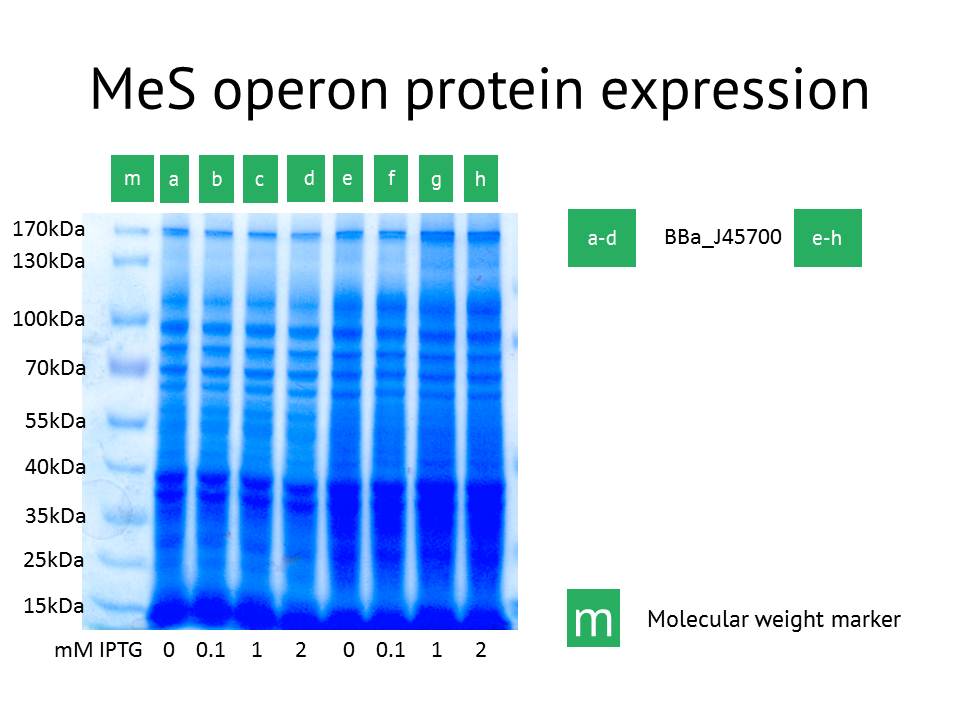Part:BBa_K1060003:Experience
This experience page is provided so that any user may enter their experience using this part.
Please enter
how you used this part and how it worked out.
Characterization of BBa_K1060003

E. coli BL21(DE3) strain
IPTG: 0,2mM
salicylate: 1mM
chorismate: 1mM
control: BL21(DE3) without plasmid and antbiotics
MeS protein expression experiment
Similar to our set-up for the EBF synthase protein expression, we tested the MIT biobrick (BBa_J45700) and our novel MeS construct via protein expression. We transformed our constructs in an E.coli expression strain, grew them at various temperatures (room temperature and 37 degrees celcius) and induced expression with increasing amounts of IPTG. We also added salicylate or chorismate to the growth medium in an attempt to increase MeS production.
The figure shows results obtained with the BBa_J45700 brick. Our biobrick showed similar results (data not shown). Increasing the amount of IPTG did not influence the protein expression profile (compare lanes a-d or lanes e-h) but we do see some bands in the lanes a-d which we cannot see in lanes e-f (eg a band just above 55 kDa). Nonetheless, this observation can be verified with lower amounts of the protein extracts. Nonetheless, our smell test would suggest that the MeS brick does work. Hence, we need a more sensitive approach to identify the protein production of the MeS brick. Possible approaches would be via classic western blot experiment or a GC-MS set-up.
Lanes a-d were induced at OD600nm 0.5, Lanes e-h were induced at OD600nm 1.0 with the indicated concentration of IPTG. Cells were grown further for 1 hrs at 25°C. An identical experiment was performed with cells grown for 6hrs after induction. Finally, the brick was also tested with cells grown at 37°C
System testing
Smell Test

To test this device several setups for smell tests where made. In the graph shown here the samples were incubated for 24h at 37°C. Methyl salicylate (MeS) has a wintergreen odor and can be detected by scent. 11 people smelled each sample independently of one another and answered if they could smell MS or not. For more details on the experimental setup and a discussion of the results go [http://2013.igem.org/Team:KU_Leuven/Project/Glucosemodel/MeS here] under 'smell test'. Chorismate was added to test the salicylate production (BBa_J45320) and salicylate to test the wintergreen odor generator (BBa_J45120).
Smell test 2.0

Here we tested and compared the activity of the original MIT 2006 Brick (BBa_J45700 and our Brick under different conditions via a blind smell test (11 participants). The MeS (wintergreen) smell got stronger from 8 to 24 hours incubation time. Growing bacteria at 37 °C also produced a more pronounced smell than those at room temperature. Addition of salicylate positively affected the smell, independent of the incubation time. The chorismate effect became only noticeable after 24 hours.
We chose to further characterise the MeS generator along with our other Bricks in the pSB1C3 shipping vector to allow comparisons to be made with other Bricks in the registry.
User Reviews
UNIQ26c132a29912f8f6-partinfo-00000000-QINU UNIQ26c132a29912f8f6-partinfo-00000001-QINU
|
•••••
|
The KU Leuven iGEM 2013 team tried to perform a qPCR on this part. It was impossible to remove the original plasmid DNA, after RNA isolation, even after several attempts with different DNase treatments. This problem is probably due to the fact that this part was provided in a high copy number backbone. If you want to perform a qPCR yourself, we recommend you to clone this part in another backbone or in the genome itself. |

